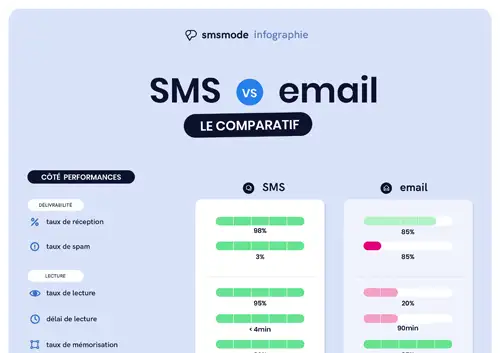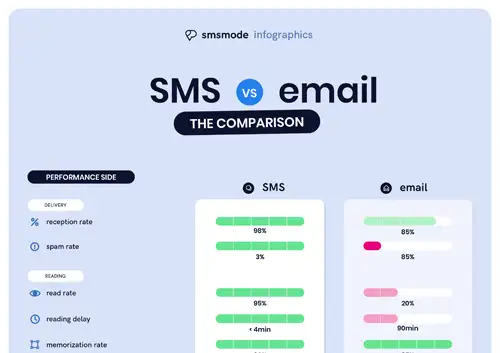COMPARATIVE
SMS or email? The ultimate comparison
- PDF AVAILABLE IN ENGLISH AND FRENCH -
SMS or email campaign? These two direct marketing channels can be used to win over new customers or relaunch an existing contact base. But which channel is more effective? Which will give you the best engagement with your target audience?
smsmode© reveals the secrets of these two tools and the comparison between SMS and email.





Download the comparison
A marketing strategy always involves sending messages. Whether you use email only, SMS or both channels, you need to ask yourself these questions: which campaigns are best suited to my communication? Will switching to SMS improve engagement? Are my email campaigns getting the open rate they deserve? How are other companies in my sector doing? Etc. etc. 🤪.
All these questions are on the minds of marketing managers in every company. Everyone wants to send their customers the right content, the right text, at the right time, with the right type of message. While there's no magic formula, it's certain that the KPIs of SMS and emailmessages are a great help in fine-tuning your marketing strategy and determining the communication to adopt, the campaigns to send or even the email message best suited to your customers. That's what our SMS vs email comparison is all about 🙂 . Find out whether email or SMS is ideal for your communications, thanks to the trends observed by companies in their marketing messages.
Open rate
95% for SMS versus 20% for email
SMS is the channel of engagement. With an open rate of 95%, it far outstrips emailing (which, moreover, only enjoys a read rate of around 15%). Emails often go unnoticed and get lost in the mailbox, among the mass of emails (144 on average for an employee) received by your customers every day. 60% of the population claim to spend at least 2 hours a day on their phone: SMS benefits from this mobile presence of the public.
Reading times
4 minutes for SMS
versus 90 minutes for email
90% of SMS messages are read within 4 minutes of being sent, whereas email has a response time of 90 minutes (when there is a reply). Only SMS guarantees immediate communication and instantaneous response from your recipient. Unlike e-mail, SMS ensures that your customers and contacts will be aware of your message very quickly.
Mobility
91% for SMS versus 72% for email
91% of people always have their mobile within reach, wherever they are and whatever the time of day. The chance of receiving SMS is therefore greater. For emailing, the experience is different. E-mail is more often consulted from a computer. 35% of emails are first opened on a computer and 59% on smartphones (source: mindbaz - 2020). SMS is the mobile channel with the best reach on phones, as it requires no Internet connection, no tools and no application download. Notification is important, when receiving an email rarely provokes more than a banner on a locked screen. So, for critical service or unmissable marketing communications, it's best to opt for SMS rather than email.
SPAM
0% for SMS versus 80% for email
8 out of 10 emails land directly in the "spam" or "junk" folder of the electronic mailbox. This is not the case for SMS , where this option simply didn't exist until 2017. Since then, the rate of SMS classified as SPAM has been stable at 10% (source: findstack). The simplicity of SMS technology (a simple text message with no formatting and limited to 160 characters) is also its strength compared to emails: a punchy, readable and easily memorable message in which it's less obvious to propose "spammy" content.